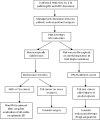Barrett's oesophagus: how should we manage it?
- PMID: 28839797
- PMCID: PMC5369571
- DOI: 10.1136/flgastro-2014-100552
Barrett's oesophagus: how should we manage it?
Abstract
Endoscopic surveillance remains the core management of non-dysplastic Barrett's oesophagus, although questions regarding its efficacy in reducing mortality from oesophageal adenocarcinoma have yet to be definitively answered, and randomised trial data are awaited. One of the main goals of current research is to achieve risk stratification, identifying those at high risk of progression. The recent British Society of Gastroenterology (BSG) guidelines on surveillance have taken a step in this direction with interval stratification on clinicopathological grounds. The majority of Barrett's oesophagus remains undiagnosed, and this has led to investigation of methods of screening for Barrett's oesophagus, ideally non-endoscopic methods capable of reliably identifying dysplasia. Chemoprevention to prevent progression is currently under investigation, and may become a key component of future treatment. The availability of effective endotherapy means that accurate identification of dysplasia is more important than ever. There is now evidence to support intervention with radiofrequency ablation (RFA) for low-grade dysplasia (LGD), but recent data have emphasised the need for consensus pathology for LGD. Ablative treatment has become well established for high-grade dysplasia, and should be employed for flat lesions where there is no visible abnormality. Of the ablative modalities, RFA has the strongest evidence base. Endoscopic resection should be performed for all visible lesions, and is now the treatment of choice for T1a tumours. Targeting those with high-risk disease will, hopefully, lead to efficacious and cost-effective surveillance, and the trend towards earlier intervention to halt progression gives cause for optimism that this will ultimately result in fewer deaths from oesophageal adenocarcinoma.
Keywords: BARRETT'S METAPLASIA; BARRETT'S OESOPHAGUS; CHEMOPREVENTION; ENDOSCOPY; SCREENING.
Figures



References
-
- Dawson JL. Adenocarcinoma of the middle oesophagus arising in an oesophagus lined by gastric (parietal) epithelium. Br J Surg 1964;51:940–2. http://www.ncbi.nlm.nih.gov/pubmed/14226058 (accessed 17 Dec 2014). doi:10.1002/bjs.1800511218 - DOI - PubMed
-
- Bani-Hani KE, Bani-Hani BK. Columnar-lined esophagus: time to drop the eponym of “Barrett”: Historical review. J Gastroenterol Hepatol 2008;23:707–15. doi:10.1111/j.1440-1746.2008.05386.x - DOI - PubMed
-
- Jankowski JA, Wright NA, Meltzer SJ, et al. . Molecular evolution of the metaplasia-dysplasia-adenocarcinoma sequence in the esophagus. Am J Pathol 1999;154:965–73. doi:10.1016/S0002-9440(10)65346-1 - DOI - PMC - PubMed
-
- Bhat S, Coleman HG, Yousef F, et al. . Risk of malignant progression in Barrett's esophagus patients: results from a large population-based study. J Natl Cancer Inst 2011;103:1049–57. doi:10.1093/jnci/djr203 - DOI - PMC - PubMed
-
- Hvid-Jensen F, Pedersen L. Incidence of adenocarcinoma among patients with Barrett's esophagus. N Engl J Med 2011;365:1375–83. http://www.nejm.org/doi/full/10.1056/Nejmoa1103042 (accessed 21 May 2014). doi:10.1056/NEJMoa1103042 - DOI - DOI - PubMed
Publication types
LinkOut - more resources
Full Text Sources
Other Literature Sources
Miscellaneous
